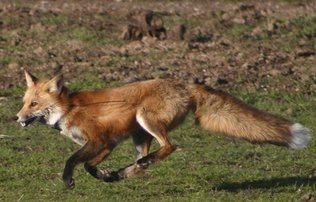
Posts Tagged: fox
Take action to help improve red fox conservation efforts

The estimated population size of Sacramento Valley (SV) red foxes is very small, indicating possible conservation concerns. In addition, SV red foxes occur in a highly modified landscape used for intensive agriculture. In particular, while preliminary analyses indicate that the current distribution of SV red foxes in the northern part of the Central Valley overlaps a floodplain once characterized by native grasslands and riparian forests, these habitats have been heavily modified to meet agricultural needs. The continuous modification of habitats for agriculture in the SV may be impeding on the limited habitats available to foxes, particularly since these foxes only live at low elevations.
Based on their unique natural history and their close proximity and dependency on human modified landscapes, SV red foxes face multiple threats. Direct threats include deaths attributed to a variety of causes: residents protecting their poultry, vehicle collisions, exposure to pathogens from domestic animals, and ingestion of poison bait meant for rodent control or eating rodents killed by poison. Additional threats for the viability of SV red foxes are the species’ limited range and distribution. Species isolated in a single region with a small population, like the SV red fox, experience minimal genetic variation in their gene flow, and could potentially face genetic introgression from adjacent non-native populations. These threats, which are likely increasing over time, may warrant placing the SV red fox on the threatened species list in the near future.
In 2007, an online reporting system was launched by the University of California, Davis, with goals of involving the public in documenting any potential fox sightings. The goal of this website was to involve the local community with locating SV red foxes so that samples could be obtained for genetic testing and surveillance could be set up for behavior monitoring.
Now, master's student Amy Brasch of Victoria University of Wellington is assessing how effective public input was on locating the foxes and how the website can be improved for future conservation efforts.
You are invited to share your opinions regarding red foxes and the fox sighting website in a 5-minute survey located on the fox sighting website: http://foxsurvey.ucdavis.edu/
The results of this survey will enhance the website as well as develop a better understanding of how effective public input is on locating Sacramento Valley red foxes.

Sacramento Valley fox pup. (Photo: Mark Statham)
Sierra Nevada red fox spotted on Sonora Pass
UC Davis researchers' recent confirmation that Sierra Nevada red fox is still roaming the forest 200 miles further south than thought could ignite a political battle about endangered species, according to an article by Michael Doyle of McClatchy News Service.
The story appeared in the Sunday Fresno Bee, but online was only available on the Miami Herald website.
California law currently protects the fox, but the federal Endangered Species Act does not. According to the McClatchy story, it is a long, politically charged process to add an animal to the federal list, and the local congressman, George Radanovich, is unlikely to support such a move.
"Our state water supply has been hijacked by the radically irresponsible Endangered Species Act," Radanovich said in a House speech last year, according to the story.
A Sept. 2 UC Davis news release about the red fox find has captivated the media. The release, picked up by dozens of news outlets and blogs, said DNA analysis of saliva from the tooth punctures on a bait bag allowed UC Davis wildlife genetics researchers Ben Sacks and Mark Statham to determine for certain that the animal is a Sierra Nevada red fox.
"It's got a genetic signature that we haven't seen outside of the skulls and skins of museum specimens collected before 1926," Sacks was quoted in the Los Angeles Times. "So we now have two small, isolated populations, and we don't know how big the second group is. That's about as endangered as you can get."
Federal biologists, UC Davis genetics researchers and university students began setting up additional monitoring stations and cameras to try to determine the size and health of the Sonora Pass population.
"It is very unusual to discover a new large animal species," a Forest Service spokeswoman told the Times. "In this case, it was like finding a rare jewel in a totally unexpected place."

UC Davis wildlife genetics researcher Ben Sacks holds a native Sacramento Valley red fox.
